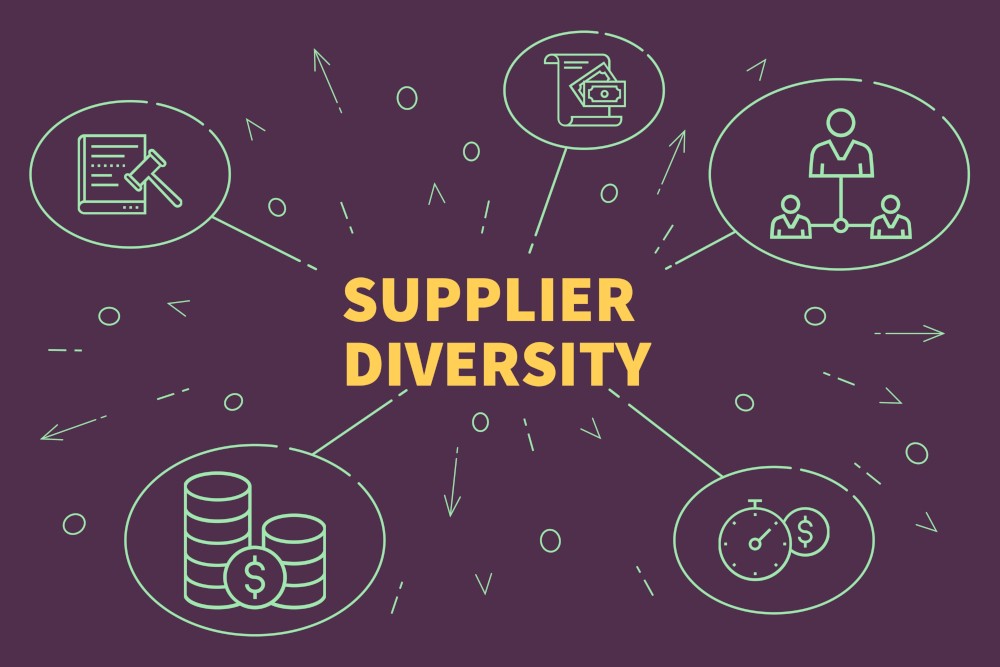While summer draws to a close and fall approaches, business leaders continue to combat rapidly changing health concerns, safety issues, economic pitfalls and the ongoing battle against ending racial injustice. Evolving efforts on how to lead remotely, design recovery plans and implement new policies are top priority.
The urgency to improve Diversity, Equity & Inclusion strategies is not a passing moment, but a movement met with a greater motivation like never before.
Although we have previously referenced the critical importance of DEI and recruiting underrepresented professionals, a key component of a sustainable DEI strategy is prioritizing an approach to supplier diversity.
The value of supplier diversity can be achieved by developing an effective plan, leveraging local resources and comprehending the relevance of supplier diversity’s history that influenced business in America 51 years ago. This article will provide our readers historical context, current resources and five best practices to help you develop a supplier diversity plan as part of your overall DEI strategy.
In transparency, as co-authors our perspectives vary. We had a passionately “uncomfortable” conversation to clarify how we would deliver best practices for supplier diversity. The painful truth about how race, albeit a social construct, framed this country and is rooted in the historical disenfranchisement of Black Americans. So, whether you agree that racial disparities are prevalent or we live in a post-racial America, we agreed that in order to provide a deeper understanding about implementing effective DEI strategies, one must remember the journey.
"Those who do not remember the past are doomed to repeat it."—George Santayana
Best Practice 1: Ensure Leadership Buy-In and Commitment to Diversity Procurement
Securing buy-in across top management needs to be the No. 1 priority. Decisions and commitments that stick come from the top in most companies, so make the business and moral case for enacting your diversity program, back it up with data and try to build support from all managers at the senior level.
Companies that avoid establishing a genuine dedication across the C-suite will attempt to seek achievement through instant gratification, resulting only in performative gestures.
The 1964 Civil Rights Movement was a fight for integration. Before Martin Luther King Jr.’s assassination in 1968, he and other leaders began to focus heavily on economic sovereignty. His progression from economic integration to sovereignty led to the Black capitalism movement and formation of supplier diversity.
In 1969, President Nixon Executive Order 11458 established the Office of Minority Business Enterprise (OMBE). Two years later in 1971, President Nixon yet again inked his name on Executive Order 11625 for the expansion of the Minority Business Development Association (MBDA), authorizing funding to both public and private organizations to provide training to minority business enterprises (MBEs).
[Related: NCBMP Chair Jason Dunn Fights for Equality in the Meetings Industry and Beyond]
Leaders that have a DEI strategy without an enforced commitment to a set of processes that increase partnership, procurement and purchases from historically underrepresented service providers, vendors and suppliers will struggle to incorporate DEI efforts into their overall business performance goals and objectives.
Best Practice #2: Learn About Local Resources for Diverse Businesses.
Partner with organizations that cater to small and diverse businesses. One of the best ways to get your organization in front of many diverse companies is through the numerous government and nonprofit entities that have been established to aid disadvantaged enterprises.
Resources:
- Small Business Administration: Created in 1953, the U.S. Small Business Administration (SBA) continues to help small business owners and entrepreneurs pursue the American dream. The SBA is the only cabinet-level federal agency fully dedicated to small business and provides counseling, capital and contracting expertise as the nation’s only go-to resource and voice for small businesses.
- The National Minority Supplier Development Council advances business opportunities for certified minority business enterprises and connects them to corporate members.
- The Minority Business Development Agency is an agency in the U.S. Department of Commerce that promotes growth and competitiveness of the United States' minority-owned businesses, including Hispanic and Latino American, Asian Pacific American, African American and Native American businesses.
- The National Business Inclusion Consortium (NBIC) is a coalition of the nation's leading business organizations representing diverse communities.
Best Practice #3: Stay Updated About Social Terms, Changes and Movements
Before going further, consider not using the word “minority.” The use of the word should be put into context.
The word minority is a culturally, ethnically or racially distinct group that coexists with, but is subordinate to, a more dominant group. The word “subordinate” is the root of the problem when using the word minority.
As a term used in the social sciences, subordinacy is the chief defining characteristic of a minority group. As such, minority status does not necessarily correlate to population. Today, there are cities with majority-minority communities.
It is advised to use the words “diverse,” “under-utilized,” “under-represented” or “disadvantaged” business, as it allows for a more inclusive conversation without implying a group is subordinate to a more dominant group.
[Related: How to Recruit Underrepresented Professionals for the Next Generation of Leaders]
Given the phrase “minority business” is embedded in outdated supplier diversity language, we will do our best to use the suggested phrase above and encourage you to do the same.
A diverse business is at minimum 51% owned and/or operated by at least one person of an ethnic or economically disadvantaged group. According to the Minority Business Development Agency, MBEs are the fastest growing segment of the population.
At a glance, according to the Census Bureau’s latest Annual Survey of Entrepreneurs (2016), there are 1,054,575 minority-owned businesses with employees in the U.S. In addition, they:
- Employ 8.7 million workers.
- Accrue a total annual payroll of $280 billion.
- Generate $1.3 trillion in total annual receipts.
Minority businesses are defined as:
- Asian American and/or Asian Pacific
- Black–African American
- Veteran or Service-Disabled Veteran Business Enterprise
- Hispanic and/or Latino
- LGBTQ+
- Women-owned business enterprises
The Small Business Administration (SBA) defines a small business as one that is independently owned and operated and not dominant in its field depending on the industry-size standard eligibility. Some of the industries include:
- Agriculture
- General/Special Trade Construction
- Manufacturing
- Retail Trade
- Wholesaling Services
Best Practice #4: Set Goals, and Measure and Take Accountability by Sharing Both Successes and Challenges
Start a supplier database by creating a database of all your suppliers, not just those that are diverse. Maintain records regarding everything you know about these companies, such as size, employees, price quotes, contract values, environmental certifications and, of course, diversity status.
Keeping a central repository of all your procurement contacts will allow you to easily compare prices, goods, services and value. Demographic data will provide benchmarks for areas of improvement and what segments of the preferred vendor and supplier list could improve in diversity.
Set measurable goals, by setting actual targets for performance. It is okay to start low by committing to making 5% of your procurements with small, minority-owned or woman-owned businesses, but make sure you set SMART goals (specific, measurable, attainable, relevant, time-bound). Then make sure you evaluate your company’s performance against these goals on a monthly or quarterly basis.
[Related: Out and Proud: The Rise of LGBT+ Representation in the Meetings Industry]
Calculating the Diversity Spend
Metrics for how diversity spend is tracked varies across companies. Some celebrate the awards they receive, while others measure their impact on diverse businesses by using economic impact tools. Primarily, knowledge of your total diversity spending includes Tier 1 and Tier 2 contracts.
- Tier 1: Prime suppliers’ invoice directly to the organization.
- Tier 2: Sub-contractors invoice the Tier 1 supplier.
Tier 2 is central, since many procurement dollars are spent with MBEs and WBEs. These spend figures can be calculated monthly, quarterly and annually.
Promote Your Diversity Successes
Once you have set and met your diversity goals, worked with some new suppliers, and attended some matchmaking events, it is time to take it to the next level.
Apply for awards related to working with diverse suppliers. Encourage your largest contractors to implement their own diversity and inclusion programs (as a bonus, you may be able to include portions of their contracts toward your own annual goals).
Put out press releases and social media updates highlighting the disadvantaged businesses new to your partner supply chain. Create friendly competitions that incentivize diverse efforts amongst your network and challenge your competitors to level up.
Companies can best promote their diversity through their meetings and events. Although supplier diversity in the meetings industry has involved the lowest effort of all industries, this is where understanding its history is imperative.
The History of Supplier Diversity in the Meetings Industry
So, where does the meetings industry fold into this timeline?
According to a professional at a supplier diversity firm we discussed this with, the effort in the meetings industry has historically and presently been viewed as “low.” She went on to say, “There are three major hospitality brands—Disney, Marriott and Hilton—that have robust programs, but it doesn’t appear to be an industry standard when compared to others such as automotive, manufacturing and transportation.”
During the height of social change from 1964 to 1975, five associations established their roots, one of which was MPI in 1972. PCMA had a 15-year head start, beginning in 1957 and the Events Industry Council (EIC), known in 1949 as the Convention Liaison Council (CLC), was the forerunner.
In the span of 24 years it was the CLC that emerged as the governing body for the industry, and which published its first manual in 1961, a glossary of industry terms in 1985 and the Accepted Practices Exchange (APEX) initiative in 2001. The voluntary standards were an attempt to regulate the entire meetings ecosystem with initial focus on software, which later evolved into all best practices.
Yet, in 2020, a quick visit to the EIC website to search the APEX gallery will return the search for SUPPLIER defined as “Purveyor, provider, vendor, contractor offering facilities, products and/or services.” A search for Diversity, Equity and/or Inclusion will give you the message, “Number of search results: 0.”
Although executive orders were legislation intended to be enforced on public and private organizations, they were socially optional.
[Related: Why Diversity and Inclusion Matter to and for Hospitality, Tourism and Meetings]
As organizations like CLC, MPI, PCMA and others formed, programs like supplier diversity were not adopted as a priority for the meetings industry. It’s time for that to change as we evolve as an industry.
The associations and governing bodies that meeting professionals rely upon for industry standards are key to ensuring that DEI strategies are a movement and not a passing moment. Meeting professionals are instrumental in promoting a brand’s diversity and essential to procuring a diverse partner ecosystem.
Best Practice #5: Challenge Biases About Working With Diverse Businesses
Leaders willing to challenge their biases can research the many studies that indicate increased performance, innovation and revenue as results of a diverse supply chain.
Competitive standards are necessary in business, but professional development and socioeconomic barriers create an unlevel playing field that lend to the disparity in success for businesses of marginalized communities.
The resources mentioned in Best Practice #2 coupled with the certification bodies below will help procurement teams ensure they comprehend disparities and are genuinely working with diverse businesses.
What is the value of a certification?
To dispel the debates regarding the value of certifications, companies must comprehend their responsibility in strengthening the pool of resources. When effective supplier diversity plans are implemented, more diverse businesses are willing to invest in the process to become certified.
When aware that there is an ROI met with opportunities to be contracted by procurement teams and leaders, more diverse businesses will also work harder to build their operations and infrastructures to meet expectations of proposals.
What are the certifications?
- MBE: Minority Business Enterprise certification, which can be awarded locally, by state or nationally via the National Minority Supplier Development Council
- DBE: Disadvantaged Business Enterprise certification
- WBE: Women-owners Business certification
- Veteran or Service-Disabled Veteran-owned certification
- LGBTBE: Business Enterprise majority-owned by LGBT individuals certification
Conclusion
As recent as 1970, minority-owned businesses were excluded from opportunities in both the private and public sectors. Remembering this history will allow leaders to comprehend that a successful supplier diversity plan requires a commitment beyond compliance.
Simply procuring businesses based on their diversity status but failing to learn the challenges that diverse businesses face will not help to make DEI strategies successful.
Inequality impacts the entire business ecosystem. By ensuring leadership buy-in, leveraging local resources, setting specific goals, working closely with government and community organizations, leaders can strategically implement sustainable supplier diversity plans to avoid returning to business as usual, which is a doomed repeat of the past.
Read Next: 20 Meetings Trendsetters Who Stepped Up When Their Industry Needed Them Most
About the Authors
 Zoe Moore, MS, is a Certified Diversity Practitioner. Honorably discharged from the Army in 2014 after 12 years of service, Zoe graduated California State University East Bay in 2016 with an MS in Hospitality Recreation & Tourism.
Zoe Moore, MS, is a Certified Diversity Practitioner. Honorably discharged from the Army in 2014 after 12 years of service, Zoe graduated California State University East Bay in 2016 with an MS in Hospitality Recreation & Tourism.
Immediately choosing events as her field of choice, she conducted event services for several clients locally and abroad. While very passionate about the logistics, operations and strategy behind events, her primary interests concentrate on advocacy for Inclusion & Diversity in the meetings, events and tourism industry.
 Greg DeShields, CHO, CHE, is a Certified Hospitality Educator and academic professional proficient in developing and implementing plans, strategies and initiatives specifically designed to raise destinations’ image for diverse multicultural travel.
Greg DeShields, CHO, CHE, is a Certified Hospitality Educator and academic professional proficient in developing and implementing plans, strategies and initiatives specifically designed to raise destinations’ image for diverse multicultural travel.
He is also an experienced Diversity, Equity and Inclusion practitioner and frequent presenter on specific Diversity, Equity and Inclusion fundamentals: assessment, planning, strategies and implementation to reinforce the need for organizations to lead inclusion from the top. More information about Greg can be found at his website, https://gregdeshields.com.






